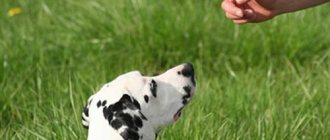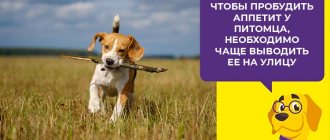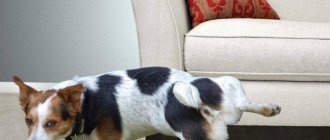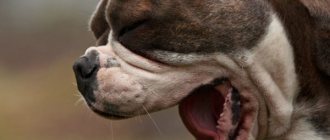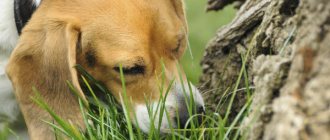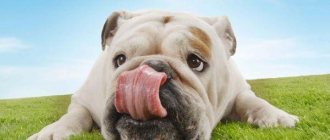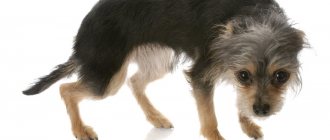Dog owners may often notice their pet sneezing. Most often, there is no reason to worry, since the dog simply frees the nasal passages from dust or accumulated mucus. In other words, it is a normal physiological process.
But if sneezing causes discomfort in the dog, is accompanied by lethargy, nasal discharge or other clinical manifestations, this is a reason to think that the pet has health problems. What symptoms threaten your four-legged friend and what diseases they could be we will look at in this article.
Causes of sneezing in dogs
Allergies (most often to environmental components - dust, pollen and many other irritants). The dog itches, sneezes, and clear mucus (snot) comes out of both nostrils. In addition to sneezing, the dog's eyes are leaking.
Possible swelling, difficulty breathing, even to the point that the dog is suffocating. There may be attacks of “sneezing” upon contact with an allergen. For example, if a pet has such a reaction to the pollen of a plant, then attacks become more frequent during a walk.
Infections , that is: viruses, bacteria, fungi. These factors can cause a huge list of diseases, the most common being canine distemper, adenovirus, coronavirus (respiratory form) and others...
Usually accompanied by lethargy, coughing and sneezing for a long time. The nose is stuffy, crusts form, conjunctivitis (discharge from the eyes). Over time, you can hear wheezing in the chest, the temperature rises, the nose is dry and warm.
In viral diseases, the snot is usually watery and transparent, and may thicken and become cloudy as the disease progresses.
With fungal infections, the discharge is viscous and smearing. This pathology is very painful for dogs, in severe cases it leads to deformation of the skull bones.
Foreign body in the nose. It could be a blade of grass or even a small stone. This usually happens to animals that constantly sniff the ground. The dog feels that something is preventing it from breathing normally and begins to snort, the receptors in the nose become irritated and it sneezes.
In cases where the pet is unable to get rid of the object in the nose on its own and it remains there for a long time, inflammation and swelling develop, which makes breathing even more difficult for the pet.
Local irritation. This happens in cases where the pet inhales caustic substances, such as smoke, perfume, or something from household chemicals. In this case, the symptoms begin to appear very quickly and sharply - the dog sneezes, rubs his nose with his paws, the discharge in this case is liquid and transparent.
Very severe inflammation develops. Sometimes there can be a chemical burn to the mucous membrane if the pet has inhaled some household chemicals.
Injury. The dog can get injured on its own, or as a consequence of surgical interventions, and sometimes because of a foreign object or an unsuccessful attempt to pull it out.
In this case, the dog sometimes sneezes blood from the nose, while it experiences pain, jerks its head, and backs away.
Tumor or polyp (in one word - neoplasm). It manifests itself in the same way as a foreign body in the nasal cavity, which interferes with normal breathing, but becomes chronic and responds little to treatment. Therefore, it makes no sense to start treating if you have not eliminated the cause of the disease - you need to remove the tumor.
Otherwise, you will relieve swelling and local irritation only for a while. Meanwhile, the tumor may increase in size. If these were polyps, then even after removal they tend to grow again, therefore, periodic examinations will be needed to ensure timely removal and prevent the growth of new polyps.
Parasites (ticks, fleas, helminths). Firstly, animals have a specific allergic reaction to the saliva of a flea or tick. Secondly, it is important to know that helminths (parasitic worms) live not only in the intestines.
There are also pulmonary helminthiases, in which case the parasites live in the bronchi of the lungs and can move up the respiratory tract. In this case, irritation of the mucous membrane occurs, the dog coughs and sneezes. Sometimes you can even observe that small worms fly out along with the mucus.
Diseases not related to the respiratory (respiratory) system - diseases of the urinary system, gastrointestinal tract, etc., can also cause sneezing. And this happens through a weakened immune system, the body becomes less resistant to bacteria and viruses, nasal discharge appears, and therefore sneezing.
In this case, you can cure a runny nose, but it will soon return until the underlying disease disappears and immunity is restored.
Frontal sinusitis is an inflammation of the frontal sinus, similar to sinusitis in humans. As a rule, it is caused by infections (both viral and bacterial etiology), or as a complication of other diseases of the respiratory system.
With this disease, the dog sneezes and produces a large amount of mucus. At the beginning of the disease, the exudate (discharge) is liquid and transparent, and the further the disease progresses, the denser and greener the discharge becomes. You shouldn’t let the disease get to this point.
Stress, anxiety, a tight collar - in these cases, sneezing is a normal process that does not require concern.
Sneezes and grunts
Grunting is a typical sound made by Mastiffs, Bulldogs and related breeds (even Pugs and Pekingese). The reason is the special structure of the muzzle and respiratory apparatus. But if grunting is accompanied by coughing, shortness of breath and sneezing, this is a reason to visit the veterinarian.
Such reflexes are the cause of helminthic infestation. Roundworms settle not only in the intestines, but also live throughout the body. If the pet is restless, often vomits, scratches the anal passage, while sneezing and grunting, then there is only one conclusion - infection with helminths. Routine cleaning should be carried out using the usual preparations.
A deadly pathology is tracheal collapse (softening of the cartilaginous rings of the trachea, blocking of the larynx, lowering the softening process to the bronchi). The disease is genetic and incurable.
Sneezing and coughing are not a reason to panic. If such attacks occur regularly, the owner knows what causes them and how to get rid of them, then there is no point in going to the clinic. But if the pathology is primary, then it is better to contact a veterinarian to find out the cause.
Reverse sneeze syndrome
It looks as if the dog is sneezing into itself, while the dog sometimes takes an unnatural pose and the sounds that the animal makes at the same time resemble an asthmatic attack. This picture often frightens the owner, but most often does not pose any danger to the dogs.
If after an attack the pet behaves as usual, the appetite and temperature are normal, then there is no need to worry.
A reverse sneezing attack can be caused by stress, a tight collar, inhalation of caustic substances, and some other factors.
This process is a spasm of the larynx. Representatives of brachycephalic breeds are especially prone to this due to the characteristics of their deformed skull.
At-risk groups
Most often, sneezing can be observed in animals kept outside, since they are forced to be in drafts and are more often exposed to hypothermia than other dogs.
Brachycephalic breeds such as Pugs, Pekingese, Boston Terriers, Bulldogs, Shih Tzus, Boxers and others. Due to the structure of their skulls, they can often be observed grunting, snoring, snoring, and sneezing, and they are also often observed to have reverse sneeze syndrome.
This always indicates that the animal is having difficulty breathing. People have made such a pathology a breed feature. You don't need to close your eyes to it. If symptoms occur frequently and interfere with the dog’s normal life, you should consult a veterinarian. You may need surgery to make breathing easier.
Treatment methods at home
Carry out independent treatment only if you understand the causes of the dog's illness .
- If the animal is hypothermic and snotty, then you can drip Pinosol drops. Dosage – 1-2 drops 2-3 times a day.
- A natural remedy for a runny nose is onions. Chop one onion, squeeze out the juice, dilute it half and half with water, moisten a cotton pad with the solution and place it in the dog’s nostrils.
- You can instill vitamin A in liquid form using a pipette.
- When crusts form, you can instill 1-2 drops of hydrogen peroxide into each nostril; when they soften, remove them with a cotton swab.
It is worth noting that there are dog breeds that naturally have a flat nose (pugs, bulldogs, etc.), and such breeds sneeze more often than their long-nosed counterparts. Therefore, you should pay special attention to their sneezing.
If we consider pets in terms of resistance to cold, then decorative dogs are more susceptible to colds, so they are walked in clothes .
Service dogs have undercoat, so the likelihood of them becoming hypothermic is minimal.
Hunting dogs require careful care. Therefore, if a dog sneezes, what should you do? There is no need to self-medicate; you should consult a veterinarian.
Important! Prevention from possible frequent sneezing and snorting can be keeping the house clean, removing dust and dirt, avoiding using things with strong odors, and limiting allergens in food.
Treatment
Treatment should be prescribed by a veterinarian after an in-person examination of the dog.
Because in order to take action for the dog’s recovery, it is necessary to determine the cause of the disease, and this is not always possible at home.
What to do before visiting the clinic?
First, examine your nasal passages. It is advisable to use a flashlight to illuminate your nose. This way you can detect foreign objects if there are any. Also, you will immediately see if there is swelling and redness; these are the first signs of inflammation.
Remove dirt and crusts around the nose using a cotton pad moistened with plain warm water.
To reduce inflammation, it is safe to use Anandin drops or a 0.15% Maksidin solution, one drop in each nostril. These drops are a complex preparation against bacteria. Helps relieve swelling and promotes tissue healing.
If after a couple of days the sneezing does not go away, does not become weaker, and the dog exhibits other symptoms - lethargy, loss of appetite, fever, you should immediately consult a doctor. There is always a danger that the dog has contracted a viral infection, which is very dangerous for the pet’s life!
The dog has snot (runny nose) and is sneezing - how to treat it
If your dog is sneezing and sniffling, it most likely has allergies . In this case, other symptoms may appear: itching, swelling of the pharynx, discharge from the ears, increased lacrimation or salivation, in especially severe cases - anaphylactic shock, epilepsy.
Read a detailed article on this topic: “Symptoms and manifestations of allergies in dogs: we figure out what causes them and how to treat them.”
To treat an allergic reaction, you must first find out the cause of its occurrence and identify the irritant. Most often, dogs suffer from food allergies, then it is worth removing chicken, wheat, corn from the diet or changing dry food to grain-free holistic food. If the irritation is caused by pollen, it is enough to limit your pet’s access to flowers. To speed up the healing process, antihistamines are prescribed.
| Drug name | Approximate cost (rubles) per package | Mode of application |
| Diazolin | 20-30 | For older and small dogs, 1 time per day, the children's dose indicated in the instructions |
| Suprastin | 120-150 | 1 time per day (injection or tablet), no more than 2 mg of active substance per 1 kg of animal |
| Allervet (1% for small dogs, 10% for large dogs) | 140-180 | A strong drug is used only to prevent an allergic attack at the rate of 1 ml per 5 kg |
| Desloratadine | 70-90 | 2 mg per 1 kg (vet consultation required) |
| Tavegil | 160-200 | 1 tablet per 60 kg dog weight, 1 time per day |
The second reason for a runny nose in a dog is rhinitis. This is an inflammation of the nasal mucosa caused by any of the above reasons: allergies, hypothermia, or foreign objects. The disease initially manifests itself with sneezing and clear discharge from the nostrils. As the disease progresses, it brings slimy, purulent snot that seals the nasal passages.
Antibacterial or anti-inflammatory drops cope well with the symptoms of rhinitis: “Bresol”, “Divopride”, “Maksidin”.
If your nose is cracked, Vaseline will help. If the lobe is too wet, it requires drying - streptocide powder. If a virus or infection is involved in the disease, you cannot do without antibiotics.
Herbal decoctions and infusions soothe irritated mucous membranes: chamomile, coltsfoot, string. They are dripped 2-3 drops into each nostril.
If a dog sneezes with pus and smells from his nose, then the disease is more serious than a cold. Purulent discharge, crusts around the nose, a sharp increase in temperature are signs of a dangerous viral disease - distemper . You can only protect yourself from it with regular vaccinations.
The infection is especially dangerous for puppies, pets with low immune resistance (due to poor nutrition, cold and damp conditions). It is difficult to cure an animal from distemper. More common is a transient death due to disruption of the central nervous system.
Read a useful article on the topic: “Dangers of cold weather - signs, symptoms, prevention of colds.”
Prevention
- It is necessary to vaccinate your animal against viral diseases in a timely manner!
- The dog should have a well-equipped “place”. If she lives in a house, then she should not lie on a cold floor or draft.
- If the dog lives on the street, he must have an insulated booth. And, despite the fact that he lives in the yard, he still needs to be walked to provide sufficient exercise and socialization. Otherwise, the dog will not have sufficient immunity.
- Periodic treatments against internal and external parasites are required!
Entry of foreign bodies into the nasal cavity
While walking, dogs explore with their noses everything they encounter along the way. If your dog, while walking, starts snorting and sneezing, waving his head, or rubbing his nose with his paw, then there is a high probability that something has gotten into his nose. There may be blood and copious mucous discharge from the nose. In such a case, the dog owner urgently needs to examine its nose and try to remove any foreign objects with tweezers. If this cannot be done, the dog must be urgently taken to a veterinary clinic to remove foreign objects from the nasal cavity.
Briefly about the main thing
- The causes of sneezing can be: allergies, infection, foreign body, local irritation, trauma, neoplasm, parasites, frontal sinusitis, stress.
- Reverse sneezing syndrome can sometimes be observed in dogs. It may look scary, but unless there are other accompanying symptoms, there is often no need to worry.
- At risk are pets with weakened immune systems and those that are often exposed to drafts and are exposed to hypothermia. As well as representatives of brachycephalic breeds.
- Treatment should be prescribed by a veterinarian after determining the cause.
- For prevention, it is necessary to vaccinate the animal in a timely manner, treat it against parasites and provide the dog with a warm “place” without drafts.
Why does my dog have a runny nose and is constantly sneezing and coughing?
Thanks to their nose and well-developed sense of smell, dogs perceive the world around them more fully. For them, the ability to smell means analyzing the information received. The sense of smell helps to navigate the area, remember the way home, and sense the approach of danger. Any runny nose leads to a temporary loss of smell, depriving the dog of the joys of life. Some animals make a living from their sense of smell, for example, sniffer dogs or hunters. It is very important for them to have a healthy nose. Having considered the main causes of runny nose in four-legged pets, you can provide timely assistance and cure the animal.
What are the possible causes of frequent sneezing?
If your dog is constantly sneezing and snorting, you need to find out the cause of the runny nose. Most often, the following factors lead to rhinitis.
Allergic reaction
Allergies can be caused by cigarette smoke.
Appears in some animals from inhalation of dust, pollen, and the strong smell of perfumes and household chemicals.
Cigarette smoke and mold in the house can also cause allergies. The body's reaction to new foods sometimes also causes sneezing and coughing. Allergies manifest themselves not only with a runny nose; in addition, the following symptoms can be observed:
- repeated sneezing when inhaling an allergen. For example, a dog is allergic to pollen, and during a walk he ran across a lawn with flowers. Pollen got into the nose and clung to the animal’s paws and fur. Hence the repeated sneezing, not only at the moment of inhalation, but also at home, after a walk;
- the allergen irritates the throat, causing coughing and wheezing while breathing;
- tearfulness;
- swelling of the nose;
- skin itching, skin irritation;
- nasal discharge in the form of watery or whitish mucus.
Perhaps the cause of the allergy is at home. If your pet constantly sneezes and snorts without going for a walk, you need to pay attention to when and after contact with what this happens. Perhaps they washed things with a new powder or purchased a floor cleaner with a different scent. Cigarettes and their smoke become a problem not only for humans, but also the dog suffers from an allergic reaction when inhaling the pungent aroma of tobacco.
Anatomical structure
Dogs with flat noses often have breathing problems.
Some dogs have a predisposition to developing a runny nose, this is due to the anatomical features of the structure of the skull and nose.
Dogs with a flattened nose experience breathing problems more often than other dogs.
Foreign body in the nasal passage
A dog with its nose in the sand may sneeze.
Sneezing can be caused by a foreign body getting into the nasal passages.
Dogs who like to pick their noses in the ground while walking suffer from blades of grass and dust particles getting into their noses. In this case, mechanical irritation of the nose occurs and sneezing occurs. This process is a natural protection against foreign objects. The pet can inhale the flea, which will also cause irritation and frequent sneezing.
A dog can injure its nose while playing.
Active pets often get injured during play. The owner may not notice that the dog has hit its nose on something hard. And already at home you will notice bloody discharge from the nose and the dog’s sneezing. In this case, it is recommended to show the animal to a veterinarian to rule out a fracture.
A runny nose and sneezing occur when infected with worms. Waste products cause poisoning of the body, immunity decreases, and it is easier for the dog to catch a cold.
Helminths can enter the animal's nostrils through inhalation and produce mechanical irritation leading to sneezing. When worms get into the throat, a cough appears. Helminthiasis can be suspected if the dog scratches its butt or tries to ride it on the surface of the floor. Although this symptom also occurs with other diseases, for example, with blockage of the paraanal glands.
When infected with worms, the dog develops a runny nose.
A dog with distemper develops a runny nose and severe lethargy.
Distemper in dogs is an infectious disease with a high mortality rate.
Therefore, it is very important to pay attention to the symptoms characteristic of this disease. In addition to a runny nose, the animal may have a cough, and its eyes begin to sour. The animal looks lethargic and joyless, refuses food, but at the same time tries to drink water. Vomiting may occur. In the case of infectious diseases, diagnosis cannot be delayed. It is necessary to call a veterinarian at home or take the dog to a veterinary clinic.
A runny nose in dogs can be accompanied by infectious tracheobronchitis and adenoviral hepatitis. Infectious and fungal diseases affect animals with weakened immune systems. Therefore, you should support your dog’s body with adequate nutrition and vitamin supplements. If the dog is sick, you should show it to the veterinarian and begin treatment immediately.
Nasal polyps prevent the animal from breathing. The pet is restless, trying to get rid of the interfering formation. The owner thinks that the dog has something stuck in the nasal passage, but attempts to get rid of the foreign body do not give positive results.
Nasal polyps prevent your dog from breathing normally.
The specialist will determine the nature of the tumor and recommend further treatment or surgical removal.
Under stress, your dog may develop a runny nose.
A long-term chronic disease leads to a weakening of the body's defenses. Microorganisms inhabiting the body are activated, and inflammatory processes occur. A runny nose can appear due to stress in a dog. Pregnancy and old age also cause nasal discharge.
>Runny nose in a dog: causes and treatment at home
